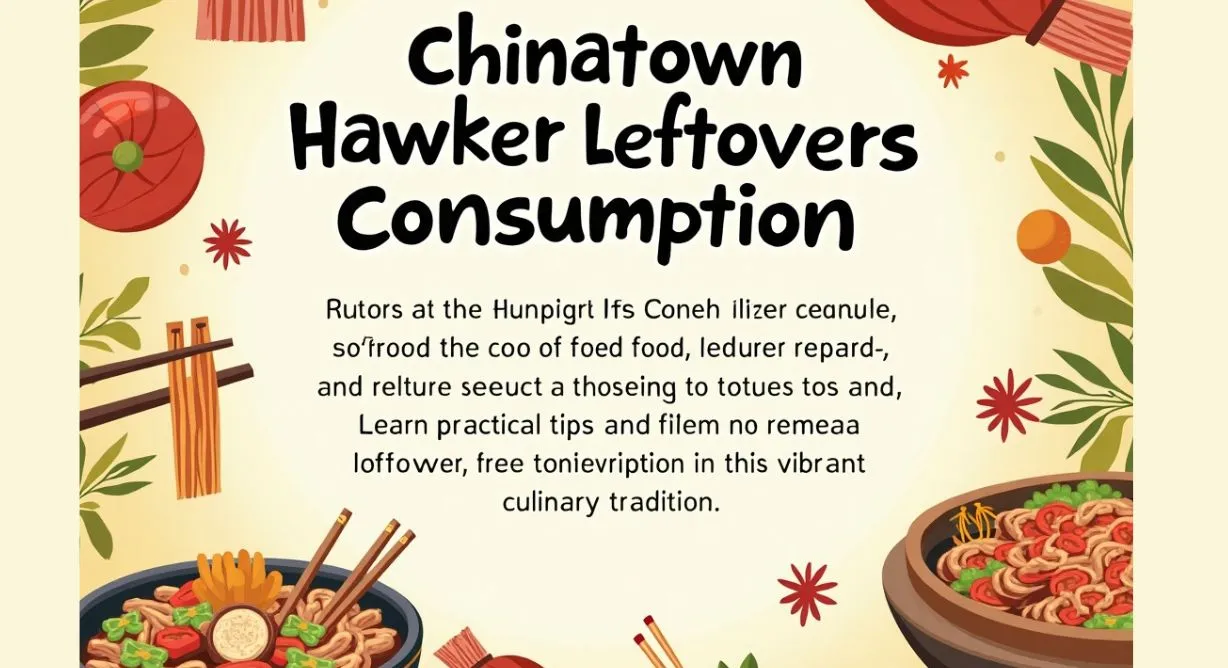Chinatown hawker centers are not just food courts—they are dynamic cultural landmarks bustling with life, rich history, and extraordinary flavors. These centers host vendors who serve a vibrant range of affordable dishes, from savory noodle soups to delectable desserts. Beyond the irresistible food, there is a growing awareness around an important, yet often overlooked practice: the mindful consumption of leftovers. This practice is deeply embedded in cultural values of frugality and sustainability, offering a powerful example of how tradition and modern environmental concerns beautifully intersect in Chinatown’s culinary scene.
Hawker Culture: Heartbeat of Chinatown
Hawker centers are more than just places to grab a quick bite—they are social hubs where culinary craftsmanship shines. Skilled vendors prepare dishes with fresh ingredients and time-honored recipes, preserving a rich heritage that spans generations. These centers bring together diverse communities, serving as melting pots where different cultures share their flavors and stories. In Chinatown, the hawker culture creates a lively, communal dining atmosphere that invites everyone to gather, savor, and connect. This vibrant setting makes the practice of leftover consumption all the more meaningful, tying together food, culture, and community spirit.
Leftovers: A Cultural Treasure
While many places view leftovers as waste or a sign of poor planning, Chinatown sees them as valuable resources deserving respect. Leftover consumption is deeply intertwined with cultural values emphasizing frugality, respect for food, and resourcefulness. It reflects an understanding that every ingredient holds worth—from the farmer who grew it to the cook who prepared it. Embracing leftovers is not only an act of environmental responsibility but a tribute to these efforts. This cultural perspective encourages mindful eating habits and reinforces a commitment to reducing food waste, making leftovers a treasured part of the Chinatown dining experience.
The Hidden Value of Leftovers
Saving Costs, Saving Food
For hawker vendors, food costs can be a major financial challenge. Unsold dishes translate into lost money, which impacts small businesses profoundly. To counter this, many vendors creatively repurpose leftover ingredients or unsold dishes, turning them into new, delicious offerings. This smart reuse reduces waste and increases profitability. Additionally, by encouraging customers to order sensible portions or share meals, vendors help minimize leftovers at the source, creating a win-win scenario that benefits both business and sustainability.
Food Brings People Together
Sharing food is a central social practice across many Asian cultures, and leftovers serve as an excellent way to extend this tradition. Leftover dishes often become the centerpiece of communal eating, where friends, family, and neighbors gather to enjoy shared meals. This practice fosters connection, warmth, and community bonding—transforming leftovers from simple scraps into valuable social experiences. Chinatown hawker centers, with their vibrant and inviting atmosphere, offer the perfect environment for such shared dining, making leftovers a catalyst for relationships and cultural exchange.
Culinary Innovation from Leftovers
Chinatown hawker vendors display remarkable culinary ingenuity by transforming leftovers into brand-new dishes. Leftover rice may be turned into fragrant fried rice bursting with flavor, while unused soup ingredients find new life in hearty broths. This skillful repurposing not only prevents waste but also showcases the creativity and expertise of the hawkers. Their ability to reinvent leftovers into tasty meals highlights a cultural tradition of food preservation, proving that leftovers are not just second best—they are opportunities for delicious innovation.
Environmental Impact: Fighting Food Waste
Food waste is one of the world’s most pressing environmental issues. The Food and Agriculture Organization estimates that one-third of all food produced globally is wasted, leading to wasted resources and increased greenhouse gas emissions that contribute to climate change. In Singapore alone, an alarming 744 million kilograms of food are discarded annually. Chinatown hawker centers, with their large volume of food production and consumption, have an important role to play in this fight. Promoting leftover consumption and creative reuse can dramatically reduce food waste, supporting environmental sustainability and easing pressure on natural resources.
Practical Steps to Embrace Leftovers
Vendor Strategies
Hawker vendors can take proactive steps to encourage leftover consumption. Designing creative menus that incorporate leftover ingredients into affordable specials attracts customers and reduces waste simultaneously. Hosting community events such as potlucks or “sharing nights” can build camaraderie and spread awareness about the benefits of leftover consumption. Simple educational signage placed around hawker centers can inform and inspire customers to embrace leftovers, helping to shift cultural norms toward sustainability.
Customer Actions
Customers have a vital role in reducing food waste too. Being mindful when ordering—choosing smaller portions or sharing dishes—can drastically cut down on leftovers. When food isn’t finished, politely requesting takeaway containers helps ensure leftovers are enjoyed later instead of discarded. Moreover, taking leftover hawker dishes home and creatively repurposing them in new meals maximizes value and flavor, turning leftovers into culinary opportunities.
Future of Chinatown Dining: Sustainable & Delicious
The consumption of leftovers in Chinatown’s hawker culture is a powerful example of how age-old traditions can help address modern sustainability challenges. This practice promotes respect for food, nurtures social bonds, and helps preserve precious resources. By embracing leftovers, both vendors and customers contribute to a greener, more responsible food system. This balance of culture, creativity, and care holds the promise of a sustainable culinary future, where every bite is cherished and waste becomes a thing of the past.
The next time you visit a Chinatown hawker center, remember that leftovers are more than just extra food—they are part of a legacy of respect, innovation, and community. Enjoy your meal, savor every bite, and join the movement toward a more sustainable dining experience.
Conclusion
The practice of consuming leftovers in Chinatown hawker centers goes far beyond simply reducing food waste—it embodies a deep cultural respect for food, creativity, and community. By valuing every morsel and repurposing unsold dishes, hawker vendors and customers together nurture a sustainable dining culture that honors tradition while addressing today’s environmental challenges. Embracing leftovers is a smart, delicious way to support small businesses, foster social connections, and protect our planet. As we continue to seek sustainable solutions in our daily lives, Chinatown’s hawker leftover culture offers an inspiring model: one where mindful eating and resourcefulness transform leftovers into opportunities for shared joy and a greener future. Next time you dine at a hawker center, savor your meal fully—and remember that every leftover saved counts toward building a more sustainable world.

